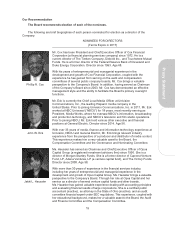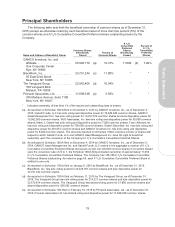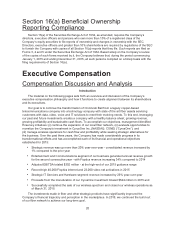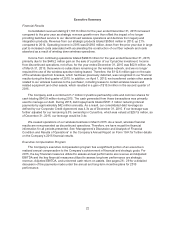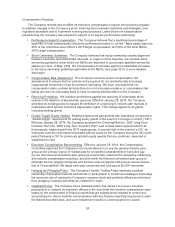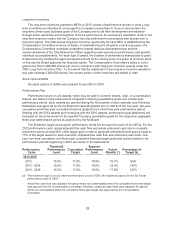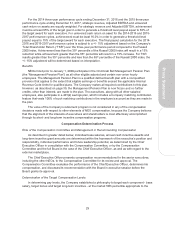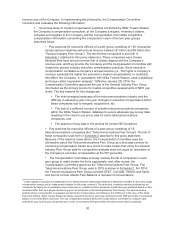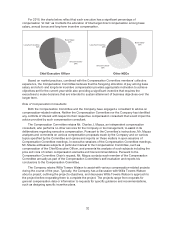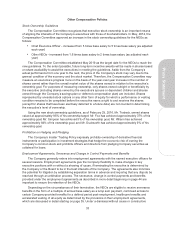Cincinnati Bell 2015 Annual Report Download - page 38
Download and view the complete annual report
Please find page 38 of the 2015 Cincinnati Bell annual report below. You can navigate through the pages in the report by either clicking on the pages listed below, or by using the keyword search tool below to find specific information within the annual report.
Compensation Practices
The Company reviews and modifies its executive compensation program and practices regularly
to address changes in the Company’s short- and long-term business objectives and strategies, new
regulatory standards and to implement evolving best practices. Listed below are compensation
practices that the Company has adopted in support of its pay-for-performance philosophy:
•Performance-based Compensation. The Company believes that a significant percentage of
each NEO’s total compensation should be performance-based or “at-risk.” Base salary was only
24% of the Chief Executive Officer’s 2015 target compensation and 39% of the other NEOs’
2015 target compensation.
•Stock Ownership Guidelines. The Company believes that equity ownership creates alignment
between executive and shareholder interests. In support of this objective, we maintain stock
ownership guidelines under which our NEOs are expected to accumulate specified ownership
stakes over time. In May, 2014, the Compensation Committee approved substantial increases
to the stock ownership guidelines applicable to the NEOs. See page 33 for a more detailed
discussion.
•Compensation Risk Assessment. The Company conducts annual compensation risk
assessments to ensure that our policies and programs do not unintentionally encourage
inappropriate behaviors or lead to excessive risk taking. We have concluded that our
compensation plans, policies and practices do not encourage excessive or unnecessary risk-
taking and are not reasonably likely to have a material adverse effect on the Company.
•Repricing Prohibition. We maintain prohibitions against the repricing of underwater stock
options in the absence of shareholder approval. Effective January 28, 2014, the Company
amended its existing policy to expand the definition of a repricing to include cash buyouts of
underwater stock options and stock appreciation rights. This change applies to all grants,
including existing grants.
•Double-Trigger Equity Vesting. Existing employment agreements with executives incorporate a
“double-trigger” requirement for vesting equity grants in the event of a change in control (“CIC”).
Effective January 28, 2014, the Company amended the Cincinnati Bell Inc. 2007 Long Term
Incentive Plan (the “2007 Long Term Incentive Plan”) and revised award agreements for all
future grants, beginning with the 2014 equity grants, to provide that in the event of a CIC, an
employee must be involuntarily terminated without cause by the Company during the 24-month
period following a CIC for previously granted equity awards that are continued, assumed or
substituted to vest.
•Executive Compensation Benchmarking. Effective January 28, 2014, the Compensation
Committee approved the Company’s recommendations to (i) use the general industry peer
group as the primary source of market data for competitive assessments of executive pay,
(ii) use the telecommunications peer group as a secondary reference for assessing market pay
and industry compensation practices, and (iii) modify the telecommunications peer group to
eliminate the four largest companies and add two new companies with annual revenue below
that of Cincinnati Bell. We target each pay component and total pay at the 50th percentile.
•Hedging and Pledging Policy. The Company’s Insider Trading Policy expressly prohibits
ownership of derivative financial instruments or participation in investment strategies that hedge
the economic risk of owning the Company’s common stock and prohibits officers and directors
from pledging Company securities as collateral for loans.
•Clawback Policy. The Company has a clawback policy that allows it to recover incentive
payments to or realized by executive officers in the event that the incentive compensation was
based on the achievement of financial results that are subsequently restated to correct any
accounting error due to material noncompliance with any financial reporting requirement under
the federal securities laws, and such restatement results in a lower payment or award.
24



